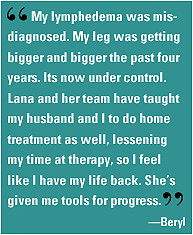 Lymphedema
and Breast Cancer
After being treated for breast cancer, some
women (and occasionally, men) develop lymphedema, the medical term for
swelling, inflammation, skin changes and discomfort caused by fluid
that builds up when the lymphatic system stops functioning normally
as a result of injury or infection. After breast cancer treatment, the
arm and hand (on the side of the involved breast), breast and chest
are the areas most often affected. The lymphatic system circulates lymphatic
fluid throughout the body to help maintain its fluid balance, remove
contaminants and transport lymphocytes, a type of white blood cell that
produces infection-fighting antibodies, an important component of the
immune system. Hundreds of small lymph nodes clustered throughout the
body produce lymphocytes and filter out impurities from lymph fluid.
Groups of lymph nodes are most easily felt when they are located close
to the skin surface, such as the underarm or the armpit (axilla), the
groin, and the neck. Lymphedema
and Breast Cancer
After being treated for breast cancer, some
women (and occasionally, men) develop lymphedema, the medical term for
swelling, inflammation, skin changes and discomfort caused by fluid
that builds up when the lymphatic system stops functioning normally
as a result of injury or infection. After breast cancer treatment, the
arm and hand (on the side of the involved breast), breast and chest
are the areas most often affected. The lymphatic system circulates lymphatic
fluid throughout the body to help maintain its fluid balance, remove
contaminants and transport lymphocytes, a type of white blood cell that
produces infection-fighting antibodies, an important component of the
immune system. Hundreds of small lymph nodes clustered throughout the
body produce lymphocytes and filter out impurities from lymph fluid.
Groups of lymph nodes are most easily felt when they are located close
to the skin surface, such as the underarm or the armpit (axilla), the
groin, and the neck.
What causes treatment-related lymphedema?
Because research about lymphedema after a breast cancer diagnosis has been limited,
the condition is not well understood. There are a variety of incidence estimates:
from 10% to 50% of female breast cancer survivors were reported to experience
lymphedema to some degree in the small number of studies available. In most cases,
post-treatment (also known as secondary) lymphedema occurs after surgical removal
of breast and chest tissue; axillary dissection (removal of underarm lymph nodes
and tissue to test for cancer) and removal of additional lymph nodes in the chest
and neck area; and/or radiation therapy (RT).
|
 Lymphedema
and Breast Cancer
Lymphedema
and Breast Cancer